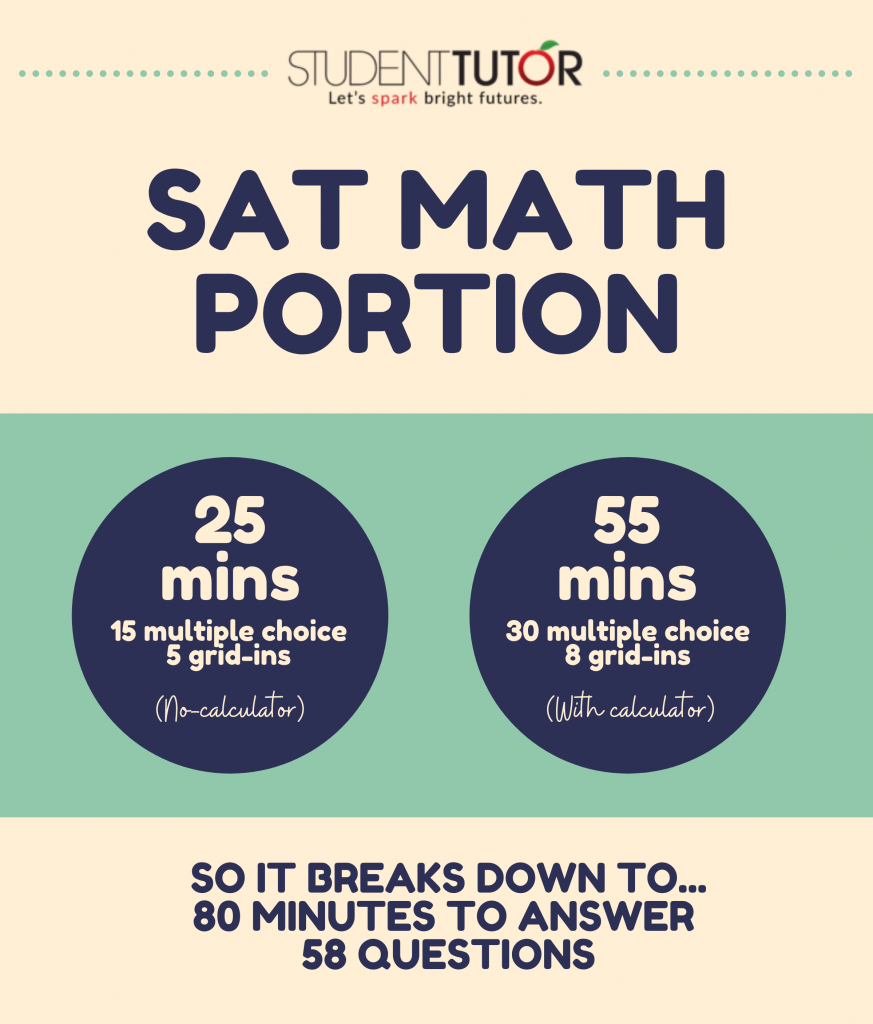If you’re getting ready to take the SAT…chances are, you’re a little nervous about the SAT Math topics. And it’s probably just because you’re not really sure what’s coming.
Will I have to do calculus? Will I need a protractor? Will I have to use pi???
But like any good warrior–or high school student–knows, half the battle for the SAT exam is knowing what to expect. And this is where we get to help you out!
In this article, we’ll go over the general structure of the math portion, the types of math covered on the SAT, and what you can skip studying.
Ready? Let’s go!
Table of Contents
What does the math portion look like?
Well, it looks something like this…

But wait one second! What’s a grid-in?
Glad you asked. Basically, with multiple-choice questions, you work out the problem and then choose an answer that’s already sitting in front of you.
But with grid-ins, you work out the problem…write your answer in boxes, and fill in the corresponding bubbles.
That’s all you need to know about the structure of the math portion of the SAT. Easy-peasy, right?
Here are some articles that can help you achieve a higher score:
- 11 Strategies Proven to Increase Your Math SAT Score
- 16 No-Calculator Tips for SAT Math
- Top 21 Math Websites for High Schoolers and Kids
Now, let’s move on to…
SAT Math Topics
Alright trooper, listen up. The math section is like a war zone, and you’re going in blind. The key is to know the enemy, understand their tactics, analyze war plans.
Ahem. What are we talking about again?
Oh, right. SAT. Math section. Types of questions. Got it.
So there are four SAT Math Topics you should know, and we’re listing them here in order of which types of questions are asked the most.
1) Heart of Algebra
Ah, good ole’ Algebra. We all know the drill. 5x=10. y=mx+b.
Alphabet soup. Exponents. Quadratic equations!
Here are some example categories of SAT Math topics under heart of algebra:
- Substitution and simplifying algebraic expressions (so, turning 3x+x into 4x.)
- Properties of exponents (Can you add ’em? Multiply ’em? Divide ’em?)
- Algebraic word problems (Somebody bought a ton of something, and you need to put it into an equation.)
- Solutions of linear equations and inequalities (4x+8=?)
See? None of these is too scary. Next up…
2) Problem Solving and Data Analysis
Of course, one of the main goals of the exam is to assess if you’re quantitatively literate that’s why it is one of the SAT math topics
Here are some example categories of SAT Math topics under problem-solving and data analysis:
- Data interpretation (tables and graphs)
- Descriptive statistics (mean, median, and mode…we all know these, right?)
- Probability
3) Passport to Advanced Math
This is one of the straightforward SAT Math topics. We mean, numbers! You know what to do with numbers.
Here are some example categories of SAT Math topics under passport to advanced Math:
- Arithmetic word problems (including percent, ratio, and proportion)
- Properties of integers (even, odd, prime numbers, divisibility, and so forth)
- Rational numbers
- Sets (union, intersection, elements)
4) Additional Topics
Shapes! Don’t be a square (heh) and make sure you study up on all your circles, triangles, and funky trapezoids!
Here are some example categories:
- Area and perimeter of a polygon (that means rectangles, triangles…anything with sides and angles!)
- Area and circumference of a circle
- The volume of a box, cube, and cylinder
- Pythagorean theorem and special properties of isosceles, equilateral, and right triangles (Remember how isosceles triangles have two equal sides? And right triangles always have a 90-degree angle? Brush up on those facts!)
Now, this is just really a brief overview, so if you want more in-depth information about the categories you’ll see on the math section, click here.
And I’m sure you’re probably wondering…
Is there anything I DON’T need?
Fortunately, you’re in luck! The answer is Yes.
Here is a quick breakdown of things you don’t need to know for the math part of the SAT:
- Imaginary numbers (anything with the letter i)
- Logarithms
- Trigonometry
- Matrices
- Long, drawn-out problems (Everything can be done easily by hand!)
- Geometry proofs
- No radians (Only degrees!)
- Standard deviations
Want a more detailed description of the things you don’t need? Click here.
Conclusion: What Kind of Math is on the SAT?
Well, there you have it. Now you have a better idea of what to expect from the SAT exam!
Let’s do a quick recap:
- There are two sections on the math portion–a no-calculator 25-minute section, and a 55-minute section.
- And there are 58 questions overall.
- There are four categories of questions…
- Heart of Algebra
- Problem Solving and Data Analysis
- Passport to Advanced Math
- Additional Topics
- You don’t need to know everything! Avoid studying concepts like imaginary numbers and geometric proof.
Also, keep in mind that calculators are allowed on the 55-minute section, as long as they are “approved” (no keyboard, can’t access the internet, etc.)
Can’t get enough math? Here are some blogs you might be interested to read:
- 13 Math Apps that Makes Learning Fun
- 15 Math Help Websites
- 51 Helpful Math Websites for Teachers and Students
What kinds of math problems are you most worried about? Do you have any study tricks? Let us know in the comments!
If you need help preparing for your SAT math topics, an excellent option may be to get a private math teacher. We invite you to contact one of Superprof’s private math tutors.
Todd VanDuzer
Latest posts by Todd VanDuzer (see all)
- Why Finding the Right Thing to Study Matters: Setting the Foundation for Success - July 26, 2023
- How USA Staff Onboarding Benefits From Innovative Software - July 26, 2023
- Top 7 Best Reasons to Get an MBA - June 7, 2023
- How to Support Your Child When They Go to College - April 29, 2023
- How to Maximize Your Job Search with Expert Resume Writers Experienced in Your Field - April 20, 2023

